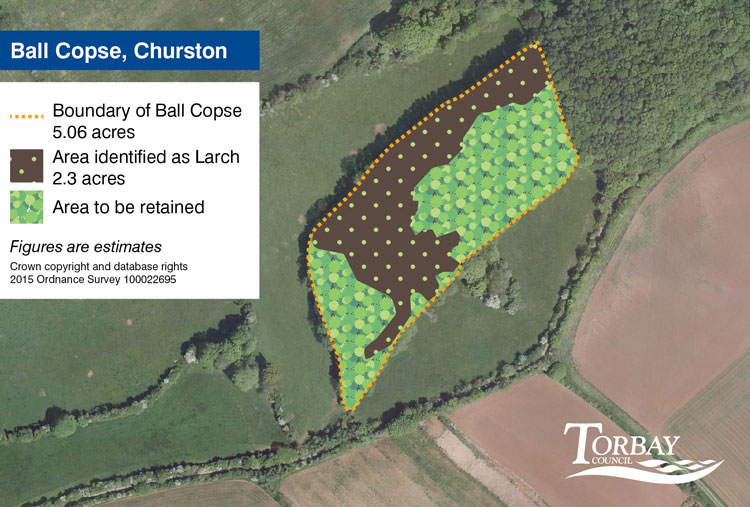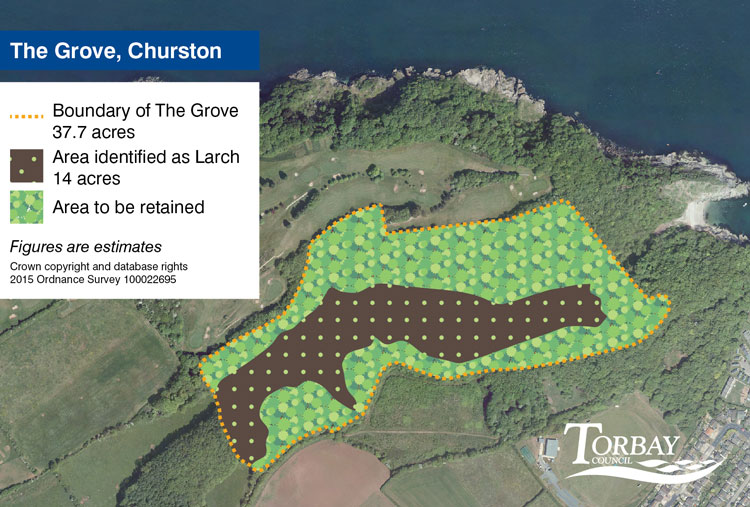
A large number of diseased trees will be felled from two woodlands in Churston - the Grove and Ball Copse, over the next 12 weeks.
The Forestry Commission confirmed the disease Phytophthora Ramorum (P.ramorum) in a number of trees following ground inspections and laboratory sample testing. P.ramorum is a fungus-like microorganism which causes extensive damage and can kill a wide range of trees and other plants.
The Grove and Ball Copse are owned by Torbay Council and managed by Torbay Coast & Countryside Trust. The Forestry Commission has served Statutory Plant Health Notices on the Trust and Torbay Council requiring that all the Larch and those Sweet Chestnut trees showing signs of disease be felled before 31 March 2017. To accelerate matters, the Trust has agreed to give Torbay Council a licence, to allow the council to enter the woodlands and manage the necessary operations.
The environmental and economic impacts can be serious if P.ramorum levels are allowed to build up in the environment, so early felling is essential to minimise the risk of the disease spreading to neighbouring trees and other plants.
Councillor Robert Excell, Executive Lead for Community Services, said: “Following the statutory notice issued by the Forestry Commission we instructed Hi-Line SW Ltd to carry out the felling works required at Ball Copse and The Grove woodlands in Churston. We continue to be very committed to ensuring the maintenance and protection of trees across Torbay which is why this felling work is necessary. Unfortunately it appears that over 1,000 Larch and Sweet Chestnut trees have been infected by P Ramorum and it is essential that we carry out these works to limit the spread of this disease to other healthy trees and plants.
“Due to large machinery being needed to carry out the work, and the large number of trees needing to be extracted, parts of the woodlands will be restricted to members of the public. This is to ensure the safety of everyone who uses the woods and it will be well signposted to show which tracks are shut.”
Damian Offer, Director of Torbay Coast & Countryside Trust said “The Trust has sought to work positively with all our partners and neighbouring land owners to tackle this problem since the Forestry Commission Notice was originally served some years ago. We are pleased that prompt action is being taken now that matters which hitherto prevented the Trust taking action to remove the infected trees have finally been resolved. While the loss of a significant number of trees is always regrettable, removal of the Larch and Sweet Chestnut does offer a great opportunity to facilitate the establishment of more appropriate native broadleaved woodland within The Grove and Ball Copse, which will offer improved habitat for wildlife.’
Mick Biddle, South West England Tree Health Officer for the Forestry Commission, said: “We are committed to minimising the spread and impact of P.ramorum disease across the country, and working with Torbay Council to protect trees and other plants in the borough. The actions which the council is taking are in line with the national P.ramorum disease management strategy, which is based on the scientific advice of the Government’s Chief Plant Health Officer. The strategy’s emphasis on early destruction of infected and likely infected plants before they can spread the disease further has helped to significantly reduce the rate of new infection in recent years.”
In preparation for these works, the council instructed HI-Line Contractors SW Ltd to create a clear access path for machinery and to safely remove logs. This path has been created on private land in agreement with the private land owner and tenant. As part of this work there are temporary parking restrictions along a section of Bascombe Road, near America Lane.
For more information about these works please visit: www.torbay.gov.uk/woodlands.
In line with the P.ramorum strategy, the Forestry Commission urge the public, tree owners and tree professionals to remain vigilant and report suspected sightings with the Forestry Commission’s Tree Alert on-line disease reporting tool at www.forestry.gov.uk/treealert.
For more information about the disease, including symptoms and the management programme, visit: www.forestry.gov.uk/pramorum.


News archive
- July 2025 (3)
- June 2025 (15)
- May 2025 (19)
- April 2025 (7)
- March 2025 (17)
- February 2025 (6)
- January 2025 (13)
- December 2024 (9)
- November 2024 (27)
- October 2024 (21)
- September 2024 (17)
- August 2024 (7)
- July 2024 (24)
- June 2024 (8)
- May 2024 (25)
- April 2024 (19)
- March 2024 (17)
- February 2024 (16)
- January 2024 (14)
- December 2023 (14)
- November 2023 (30)
- October 2023 (21)
- September 2023 (22)
- August 2023 (18)
- July 2023 (17)
- June 2023 (14)
- May 2023 (11)
- April 2023 (9)
- March 2023 (36)
- February 2023 (22)
- January 2023 (26)
- December 2022 (18)
- November 2022 (24)
- October 2022 (18)
- September 2022 (13)
- August 2022 (15)
- July 2022 (22)
- June 2022 (14)
- May 2022 (35)
- April 2022 (23)
- March 2022 (32)
- February 2022 (18)
- January 2022 (14)
- December 2021 (22)
- November 2021 (22)
- October 2021 (25)
- September 2021 (23)
- August 2021 (18)
- July 2021 (26)
- June 2021 (24)
- May 2021 (21)
- April 2021 (21)
- March 2021 (33)
- February 2021 (30)
- January 2021 (27)
- December 2020 (24)
- November 2020 (37)
- October 2020 (29)
- September 2020 (27)
- August 2020 (22)
- July 2020 (37)
- June 2020 (38)
- May 2020 (39)
- April 2020 (36)
- March 2020 (22)
- February 2020 (10)
- January 2020 (18)
- December 2019 (7)
- November 2019 (11)
- October 2019 (15)
- September 2019 (16)
- August 2019 (8)
- July 2019 (9)
- June 2019 (7)
- May 2019 (16)
- April 2019 (11)
- March 2019 (11)
- February 2019 (7)
- January 2019 (11)
- December 2018 (11)
- November 2018 (14)
- October 2018 (14)
- September 2018 (9)
- August 2018 (7)
- July 2018 (19)
- June 2018 (21)
- May 2018 (7)
- April 2018 (10)
- March 2018 (35)
- February 2018 (9)
- January 2018 (15)
- December 2017 (9)
- November 2017 (17)
- October 2017 (11)
- September 2017 (6)
- August 2017 (7)
- July 2017 (13)
- June 2017 (22)
- May 2017 (16)
- April 2017 (8)
- March 2017 (9)
- February 2017 (9)
- January 2017 (4)
- December 2016 (10)
- November 2016 (11)
- October 2016 (14)
- September 2016 (9)
- August 2016 (10)
- July 2016 (11)
- June 2016 (4)
- May 2016 (20)
- April 2016 (14)
- March 2016 (18)
- February 2016 (8)
- January 2016 (15)
- December 2015 (13)
- November 2015 (19)
- October 2015 (17)
- September 2015 (8)
- August 2015 (6)
- July 2015 (19)
- June 2015 (11)
- May 2015 (20)
- April 2015 (14)
- March 2015 (15)
- February 2015 (13)
- January 2015 (17)
- December 2014 (17)
- November 2014 (18)
- October 2014 (14)
- September 2014 (17)
- August 2014 (16)
- July 2014 (10)
- June 2014 (8)
- May 2014 (1)
- February 2014 (1)
- January 0001 (1)